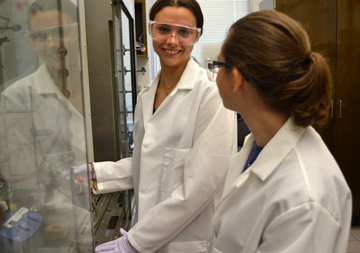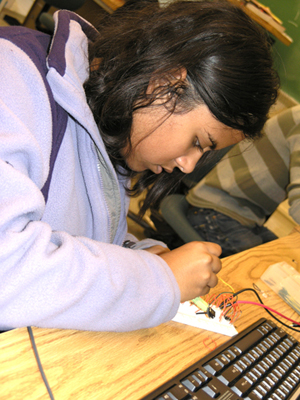Illinois to Participate in AAU Initiative to Improve Undergraduate STEM Education

Illinois has found research experiences for undergraduates, like the one in which the student above is participating, to be effective in the retention of students in STEM majors.
August 16, 2012
As the nation's need for more STEM graduates has increased, so has the need to improve our undergraduate STEM education. The Association of American Universities (AAU), of which Illinois is a member, has established a 5-year initiative on STEM (science, technology, engineering, and mathematics) undergraduate teaching. Particularly focused on the first two years of college, the initiative seeks to help higher education institutions assess the quality of STEM teaching, share best practices, and encourage the use of the most effective STEM teaching methods.
The need to improve America's undergraduate education has been established by several high-level reports, which have identified deficiencies and potential solutions, such as the use of effective instructional techniques demonstrated to engage students, thus helping them learn. Because Illinois is at the forefront of institutions working to address this need, the AAU has approached the university to be one of the lead agencies involved in this initiative. Chancellor Phyllis Wise has appointed I-STEM Director Lizanne DeStefano to serve as the Illinois liaison.
A technical advisory committee of experts in undergraduate STEM teaching and learning will help guide the initiative and assist AAU to meet the following goals:
- Develop an analytical framework to assess and improve the quality of STEM teaching and learning, particularly in the first two years of college.
- Create a demonstration program to implement the framework at a subset of AAU universities and develop tools to assess: a) the quality of STEM teaching and learning; b) the extent to which effective teaching methods are used; and c) the effects of improved teaching on retention of STEM majors and degree completion.
- Explore mechanisms to train, recognize, and reward faculty who improve the quality of their STEM teaching.
- Work with federal agencies to recognize, reward, and promote efforts to improve undergraduate learning.
- Determine the best methods to evaluate and share information about effective undergraduate STEM education.

Illinois student does hands-on project in an engineering undergraduate course.
Integrating teaching and research in the classrooms of U.S. research universities can benefit student learning. However, to improve STEM education to the degree that our nation's demands for a highly trained, STEM-literate workforce are met, a variety of organizations, such as higher education associations, individual universities, disciplinary societies, federal agencies, and the business community must work together. Thus, AAU will establish a task force to guide initiative efforts and play a key role in the framework demonstration program. In addition to the member universities, the AAU will work with the Association of Public and Land-grant Universities; the Business-Higher Education Forum; the Howard Hughes Medical Institute; the President's Council of Advisors on Science and Technology; and various disciplinary societies, including the American Physical Society. It is hoped that by fostering the collaboration of these institutions toward a shared goal, the initiative can improve undergraduate STEM education and retention at all levels.
AAU web article: AAU Undergraduate STEM Education Initiative
Author, photographer: Elizabeth Innes, Communications Specialist, I-STEM Education Initiative
More: I-STEM Initiatives, Undergrad Education Reform,
2012













.jpg)
















